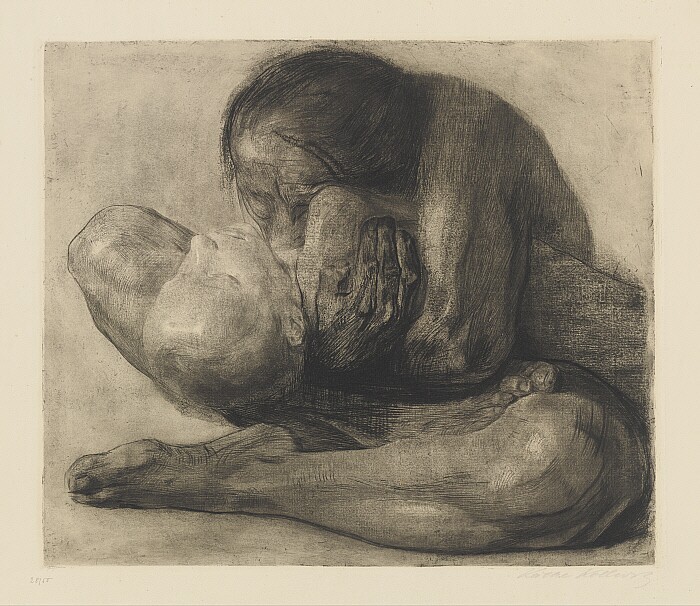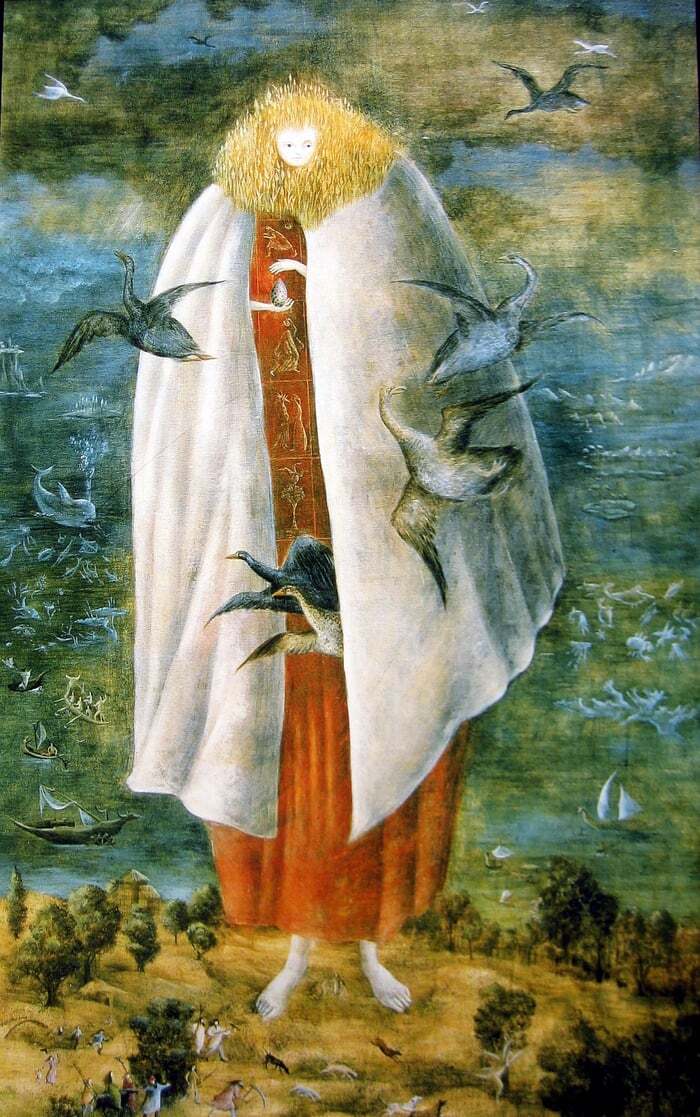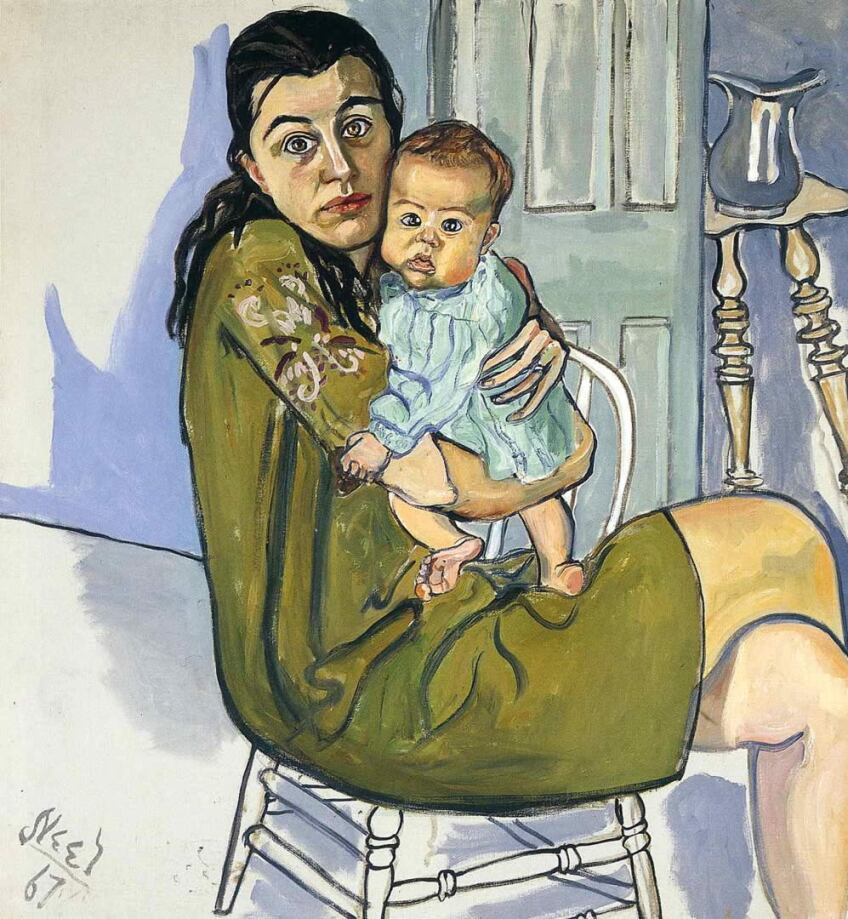The 10 Most Powerful Artworks on Motherhood from the 20th century

Art about motherhood has been devalued just about as long as the work of raising children has, and too many artists who go that route are quickly labeled eccentric. But starting in the 20th century, we can find many examples of artworks that use the images or materials of motherhood to great effect. Here are my picks for the ten most powerful motherhood-related works from that time. A few pieces have a quiet strength. Others are perhaps understandably more aggressive, demanding attention and insisting that what seems eccentric to others is actually a central source of activity and creativity.
Käthe Kollwitz: Frau mit Totem Kind (Woman with Dead Child), 1903

A German artist who feels urgent today because of her interest in social issues like the physical and emotional toll of poverty, Kollwitz in 1903 made drawings and etchings of a woman cradling her dead child. We don’t know the conditions of his death, but we are shown the way that event has just cratered another life. The child’s face is pale, calm, symmetrical, or in aesthetic terms classical. The mother is the opposite, rendered in dark, scratchy, expressionistic lines — her eyes almost like gouges — giving the impression her skin itself is torn by grief. The picture is also haunted by a wrenching irony: Kollwitz used her seven-year-old son Peter to model for the child. Eleven years later, Peter was killed in World War I, prompting more expressions of grief from Kollwitz.
Louise Bourgeois’s Femme Maison (Wife House), 1947

Bourgeois’s late-in-life, larger-than-life bronze and steel sculptures of spiders are widely celebrated for their dark exploration of family dynamics, with the “maman” given spindly, spiky legs that make her an ambivalent figure, to say the least. But I have always had a soft spot for Bourgeois’s unflinching “femme maison” paintings from nearly half a century earlier. I especially like the full-length drawing done in 1947 of a nude woman, only in place of her torso and head stands a house with many floors and numerous tiny windows. The house has literally taken over her brain. The French-born, American-based Bourgeois gave it the title “femme maison.” It’s usually translated as “woman house” but also means “wife house,” a play on the English construction “housewife,” which posits, like this drawing, a woman who fundamentally supports her house, is entirely defined by her house and might as well be married to her house.
Leonora Carrington’s The Giantess (also known as The Guardian of the Egg), circa 1947

Of all earth mother imagery, this Surrealist giantess seems like the fertility queen. Her hair is made of golden wheat. Birds flock to her like she’s a tree rooted in the earth. She holds in her hands a precious black egg. She stands large enough to encompass land, sea and sky, a sort of cosmic explorer or creator. Born in England to a British father and Irish mother, Carrington painted this painting as an expat in Mexico in the late 1940s, and you could trace the monumentality of the main figure back to the Mexican muralists. Others see the influence of Celtic mythology in particular symbols like her geese. And others yet see a vaguely Christian framework, noting that her fertility goddess has a red robe and golden halo that recalls Old Masters paintings of the Madonna. I love the fact that this painting is always more mystery than solution.
Ruth Asawa’s Looped Wire Installations, 1950s-90s

Asawa’s sculpture is so often viewed through her roles as mother and local arts educator in San Francisco, with Imogen Cunningham capturing images of her kid-packed studio looking like a progressive preschool, that a scholarly effort has been made lately to not read her work too much against domesticity. But I can’t help but see her crocheted wire sculptures, at least those arranged in constellations hanging from the ceiling, as robust families of forms. Her lengthy, wavy biomorphic shapes resemble spiraling DNA strands, and her forms relate to each other as intimately — and stubbornly independently — as siblings do.
Alice Neel’s Nancy and Olivia, 1967

Have you ever seen so many ugly greens in one painting at once? While so many mother-and-child paintings celebrate a moment of tenderness or communion, Neel manages in this portrait of her daughter-in-law to capture the slightly ugly and terribly awkward reality of suddenly being the caregiver responsible for keeping another person alive. The mother looks startled to even be there, her expression tired but vigilant, and the baby hyper alert. This is motherhood as an extended adrenaline rush.
Marisa Merz’s Scarpette (Little Shoes), 1968-1980s

In the world of Merz’s beautifully humble objects, nothing speaks to her own family life and the continuity between homemaking and artmaking quite as powerfully as the small slipper-style shoes she knitted for herself and her daughter Beatrice from nylon thread or copper wire. They are simple-looking objects with a complex status: wearable but also museum-pedestal pieces, useful until they are useless. For one 1970 performance, she took the little shoes to the beach outside of Rome and let the waves of the Mediterranean knock them around. They reference domesticity and transcend domesticity. I think they are stubborn little shoes.
Mary Kelly’s Post-Partum Document, 1973-79

When this series was first exhibited at the Institute of Contemporary Art in London in 1976, it was a sensation for all the wrong reasons: the dirty diaper liners that Kelly framed as part of her documentation of her son’s first years sparked the usual “is this art or rubbish?” controversy. Increasingly the series has been appreciated as radical in other ways: one of the most rigorous and systematic attempts to create a psychoanalytic matrix for analyzing the daily events and developmental milestones of a young mother’s life: her son’s early sentences, scribbles and, yes, diaper liners meticulously recorded and framed. Kelly recently said the biggest misperception is that the work is a faithful recording of her son’s fist years like some sort of conceptual-art keepsake book. It’s more, she said, about the mother’s experience and even separation anxiety as her son gains independence in the world.
Celeida Tostes's Passagem (Passage), 1979

First the Brazilian artist Celeida Tostes embedded small, noisy objects inside clay eggs or spheres that looked like wombs. Then, for an epic work in 1979, she placed herself inside one: smearing herself with liquid clay then climbing into what art historian Maria Angélica Melendi has described in the catalogue for "Radical Women: Latin American Art, 1960-85" as "an enormous vat of unbaked clay suggestive of both an indigenous funeral urn and a womb." She had assistants seal her inside the vessel before she emerged, reborn, from it. The photographs documenting the performance, a highlight of "Radical Women," are moving: They document a woman struggling to conjure up an absent mother, an individual losing herself in the undifferentiated muck of pre-life (in a related poem, she wonders if she is mineral, animal or vegetable), and an artist symbolically giving birth to herself.
Judy Chicago’s Birth Project, 1980-85

One of Chicago’s most important and least appreciated projects, this series consists of dozens of tapestries and mixed-medium works featuring birthing imagery made in collaboration with some 150 needleworkers. Not a mother herself, Chicago asked others for accounts and also witnessed friends giving birth to capture what she has described as “the glory and horror of the birth experience itself, the joy and pain of pregnancy, the sense of entrapment that goes along with the satisfactions of giving life.” While the choice of medium clearly comes from the domestic realm, the highly stylized (and often boldly, some would say garishly, colored) images of female legs spread for a non-sexual reason gives the work its punch.
Senga Nengudi’s R.S.V.P., 1975-present

I have to admit I probably saw three or four different versions of R.S.V.P., the performance-activated sculpture that Nengudi made by filling pantyhose with sand and stretching it across corners or rooms, before thinking about the improbable elasticity of the pregnant body. But that is exactly how Nengudi herself described the work, large enough to contain multitudes, to a Chicago Tribune reporter last year. “I'd just had my two children and was fascinated with this issue of pregnancy, how you expand beyond all recognition sometimes,” Nengudi said. “And then your body is so resilient and just bounces back into shape — well, pretty much so. There was also the elasticity of the psyche during pregnancy, this constant resilience that the body enacts.”
Top Image: Judy Chicago, The Creation from the Birth Project, 1984, Modified Aubusson tapestry 42 x 163 inches. Executed by Audrey Cowan Collection of the Museum of Arts and Design, NY; gift of the Robert and Audrey Cowan Family Trust







